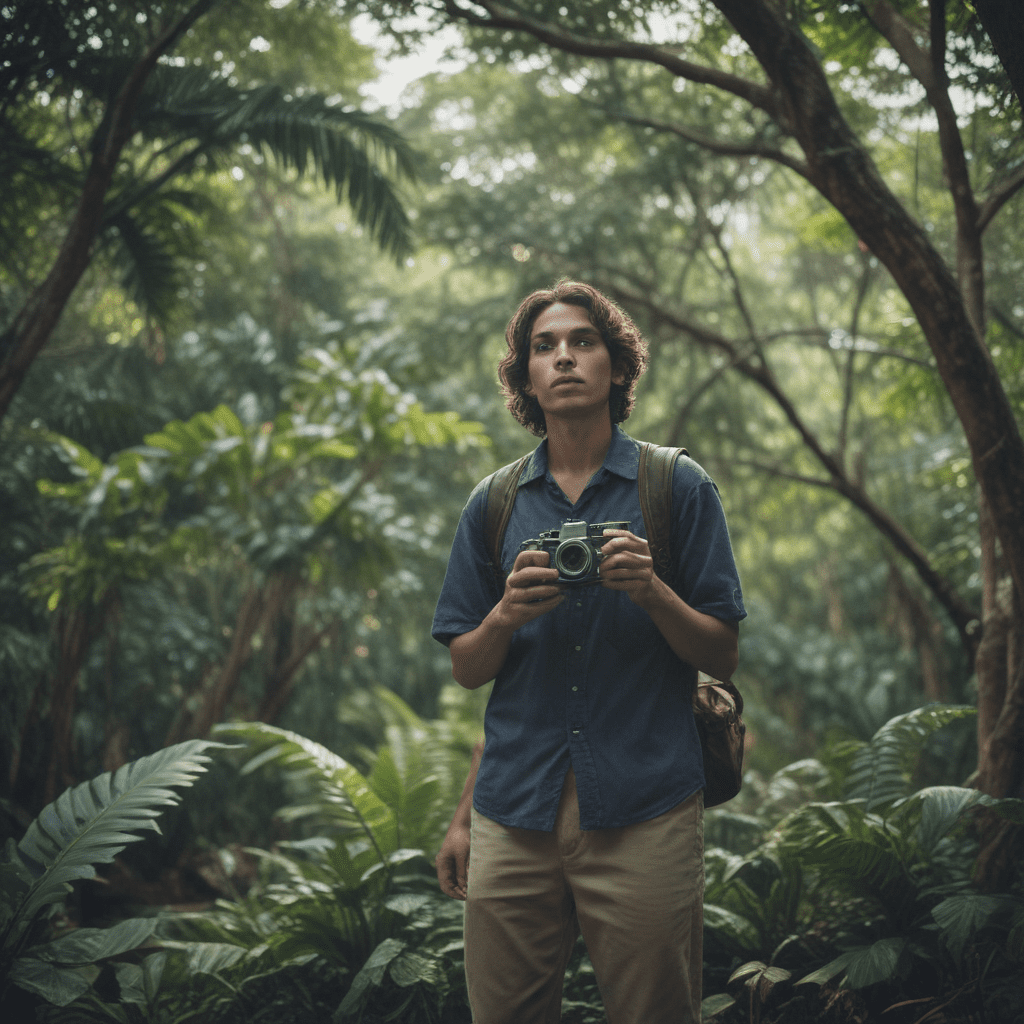
1. Overview: A Biodiverse Paradise
Welcome to Belize, a Central American nation renowned for its breathtaking biodiversity, where lush rainforests teem with life and pristine Caribbean waters harbor an underwater wonderland. From the majestic jaguars that roam the jungle depths to the vibrant coral reefs teeming with colorful fish, Belize offers a unique opportunity to connect with nature. This comprehensive guide will take you on a captivating journey through Belize's captivating flora and fauna, unveiling the hidden treasures of this ecological gem.
2. Delving into the Lush Jungles:
2.1. A Tapestry of Trees and Vines:
Belize's jungles are a botanical paradise, where towering mahogany trees stand guard over a tapestry of orchids, ferns, and exotic vines. The air is thick with the fragrance of blooming flowers, while the dense canopy filters the sunlight, creating a mystical ambiance. As you wander through the undergrowth, you'll encounter strangler figs with their aerial roots and ancient kapok trees whose massive trunks provide refuge for a multitude of creatures.
2.2. Mammals: Howler Monkeys, Jaguars, and More:
The jungles of Belize are home to an astonishing array of mammals, from the elusive jaguar, the apex predator of the rainforest, to the playful spider monkeys swinging through the treetops. Listen for the unmistakable howls of the black howler monkeys as they announce their presence, while the smaller night monkeys and kinkajous venture out under the cloak of darkness. Tapirs, with their distinctive snouts, roam the forest floor, while armadillos and opossums scavenge for food among the fallen leaves.
2.3. Birds: Toucans, Parrots, and the Melodies of the Forest:
Belize's forests are a symphony of bird songs, with over 500 species flitting through the branches. The vibrant keel-billed toucan, with its oversized beak, is a common sight, as are the scarlet macaws, their feathers a splash of color against the green canvas. Hummingbirds dart from flower to flower, while parrots chatter and screech, adding to the cacophony of the jungle. Listen for the haunting call of the pauraque, a nocturnal bird, and the rhythmic drumming of the woodpeckers as they search for insects beneath the bark.
3. Exploring the Coastline:
3.1. Mangroves: A Vital Ecosystem:
Belize's coastline is fringed by extensive mangrove forests, which act as a vital nursery for marine life and provide protection from coastal erosion. These unique ecosystems thrive in the salty water, their tangled roots creating a labyrinthine world teeming with life. Crabs scurry among the mud, while fish dart in and out of the submerged roots, seeking refuge from predators. Herons and egrets perch on the branches, their sharp eyes scanning for prey, while the distinctive calls of the mangrove cuckoo fill the air.
3.2. Marine Life: Sea Turtles, Sharks, and Coral Reefs:
Beneath the turquoise waters of Belize, a dazzling array of marine life awaits discovery. The Belize Barrier Reef, the second-largest in the world, is a haven for countless species, from vibrant coral formations to graceful sea turtles. Schools of colorful fish flit through the coral, their scales shimmering in the sunlight. Sharks glide effortlessly through the water, their sleek forms a reminder of the ocean's power. Keep an eye out for the majestic whale sharks, the largest fish in the sea, as they filter-feed through the plankton-rich waters.
3.3. Coastal Birds: Pelicans, Frigatebirds, and More:
The Belizean coastline is a haven for a diverse array of birdlife. Pelicans soar overhead, their massive wingspans casting shadows on the water as they dive for fish. Frigatebirds, with their distinctive inflatable throat pouches, patrol the skies, pirating food from other birds. Gulls and terns wheel and cry above the waves, while the elegant roseate spoonbill wades in the shallows, its long beak sifting through the mud for crustaceans. The coast is also a nesting ground for many seabirds, including the endangered brown booby and the magnificent frigatebird.
4. Discovering the Caves and Underground World:
4.1. The Maya Mountains: A Realm of Caves and Sinkholes:
Beneath the lush jungles of Belize lies a hidden world of caves and sinkholes, a geological wonderland carved by ancient rivers and the relentless forces of time. The Maya Mountains are riddled with these subterranean chambers, some adorned with stunning stalactites and stalagmites, others harboring ancient Mayan artifacts and hidden waterfalls. Explore the ATM Cave, a sacred site for the Maya, where you can witness intricate cave paintings and ceramic offerings left behind centuries ago.
4.2. Bats: Masters of the Darkness:
The caves of Belize are home to a staggering diversity of bat species, numbering over 100. These nocturnal creatures, adapted to life in the darkness, play a vital role in the ecosystem as pollinators and insect controllers. As dusk settles, witness the spectacular sight of millions of bats emerging from their cave roosts, filling the twilight sky with a mesmerizing ballet of flight.
4.3. Cave Fauna: Blind Fish, Insects, and Other Adapted Creatures:
The caves of Belize are home to a unique assemblage of creatures that have adapted to life in the perpetual darkness. Blind fish, with their translucent bodies and heightened senses, navigate the subterranean waters with ease. Cave crickets chirp and scuttle among the rocks, while specialized spiders spin webs to trap unsuspecting prey. These creatures, evolved in the absence of light, showcase the remarkable resilience and adaptability of life.
5. Preserving Belize's Biodiversity:
5.1. Conservation Efforts and Protected Areas:
Belize is committed to preserving its rich biodiversity, with over 40% of its land area designated as protected areas. National parks, wildlife sanctuaries, and marine reserves provide safe havens for endangered species and help maintain ecological balance. The Belize Audubon Society, a leading conservation organization, plays a crucial role in protecting important habitats and promoting sustainable practices.
5.2. The Importance of Ecotourism:
Ecotourism offers a sustainable way to experience Belize's natural wonders while supporting conservation efforts. By choosing responsible tour operators and minimizing environmental impact, visitors can contribute to the protection of Belize's precious ecosystems. Ecotourism also creates economic opportunities for local communities, fostering a sense of ownership and stewardship for the environment.
5.3. Challenges and Solutions:
Despite the ongoing conservation efforts, Belize faces numerous challenges to biodiversity conservation, including habitat loss, climate change, and unsustainable agricultural practices. By working together, government agencies, conservation organizations, and local communities can implement effective solutions to address these threats and ensure the long-term health of Belize's natural heritage.
6. Visiting Belize: A Journey of Discovery:
6.1. Planning Your Trip: Best Times and Places to Visit:
The best time to visit Belize is during the dry season, which runs from December to April. This period offers the most pleasant weather for outdoor activities and wildlife viewing. However, the shoulder seasons (May-June and September-November) can also be enjoyable, with fewer crowds and potential for lower prices. When choosing where to go, consider your interests. For exploring ancient Maya ruins, visit Caracol or Xunantunich. For snorkeling and diving, head to the Belize Barrier Reef or the Hol Chan Marine Reserve. If you're seeking adventure, try cave tubing in the ATM Cave or zip-lining through the rainforest canopy.
6.2. Activities and Experiences: Hiking, Snorkeling, and More:
Belize offers a plethora of activities for nature enthusiasts. Hike through the lush rainforests, spot exotic birds and mammals, and immerse yourself in the vibrant biodiversity. Embark on a snorkeling or diving adventure to discover the underwater world of coral reefs, sea turtles, and sharks. Go cave tubing or kayaking through ancient cave systems, or explore Maya ruins and learn about Belize's rich cultural heritage. Whether you're seeking adrenaline-pumping adventures or peaceful encounters with nature, Belize has something for everyone.
Frequently Asked Questions (FAQ):
Q: What is the best way to get to Belize?
A: The main airport in Belize is Philip S.W. Goldson International Airport (BZE), located near Belize City. Numerous airlines offer direct flights from major cities in the United States, Canada, and Europe.
Q: Is it safe to travel to Belize?
A: Generally, Belize is a safe country for tourists. However, it's always wise to exercise caution and be aware of your surroundings, especially in crowded areas or at night.
Q: What type of currency is used in Belize?
A: The official currency of Belize is the Belizean dollar (BZD), which is pegged to the US dollar at a rate of 2 BZD to 1 USD. US dollars are widely accepted throughout Belize.
Q: What language is spoken in Belize?
A: The official language of Belize is English, although Spanish and Kriol (a Creole language) are also widely spoken.
Q: What are some tips for planning a trip to Belize?
A: Research and book your accommodations and activities in advance, especially during peak season. Pack comfortable clothing, sunscreen, insect repellent, and a hat. Consider purchasing travel insurance to protect against unexpected events. Be respectful of local customs and traditions, and contribute to the preservation of Belize's natural beauty.

